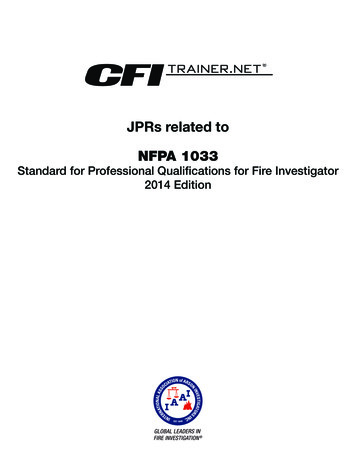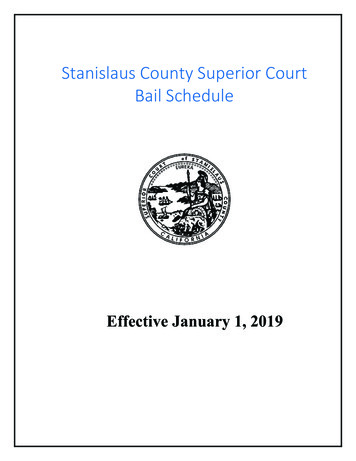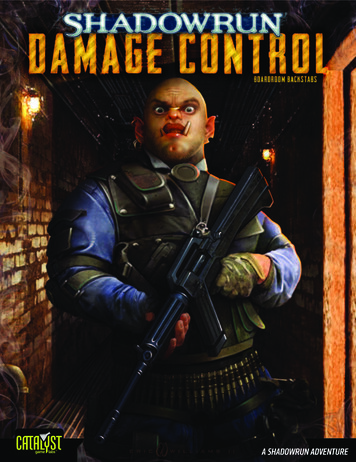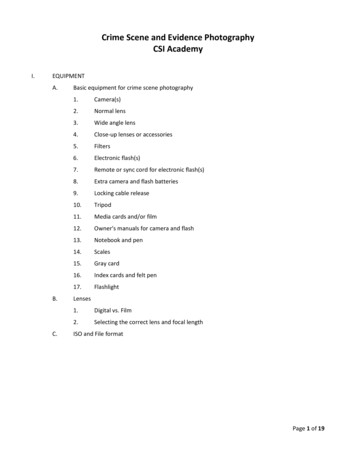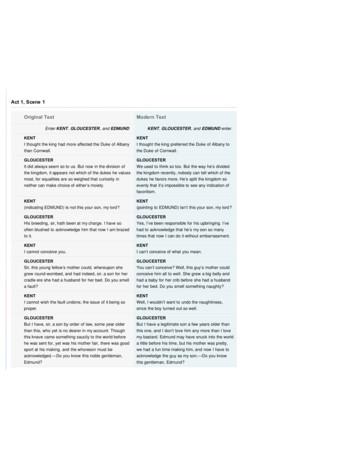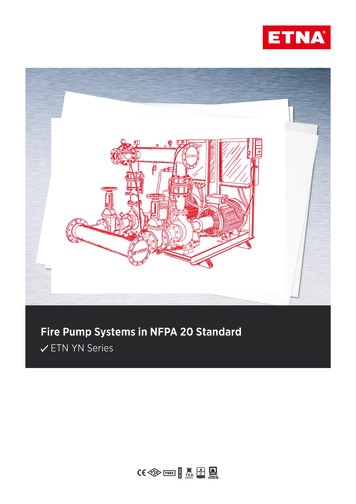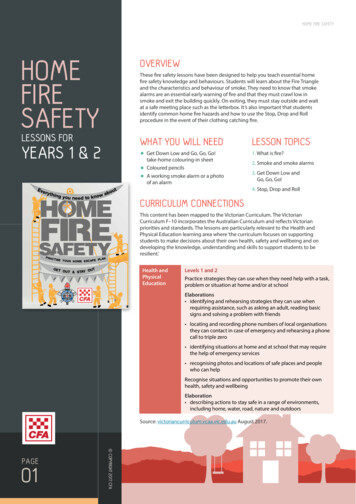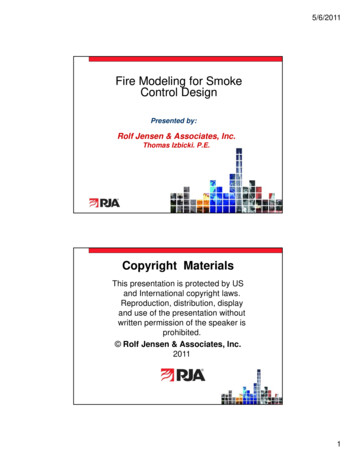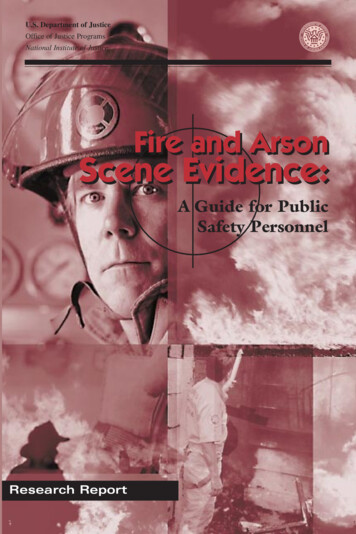
Transcription
U.S. Department of JusticeOffice of Justice ProgramsNational Institute of JusticeFire and ArsonScene Evidence:A Guide for PublicSafety PersonnelResearch Report
U.S. Department of JusticeOffice of Justice Programs810 Seventh Street N.W.Washington, DC 20531Janet RenoAttorney GeneralDaniel MarcusActing Associate Attorney GeneralMary Lou LearyActing Assistant Attorney GeneralJulie E. SamuelsActing Director, National Institute of JusticeOffice of Justice ProgramsWorld Wide Web Sitehttp://www.ojp.usdoj.govNational Institute of JusticeWorld Wide Web Sitehttp://www.ojp.usdoj.gov/nij
Fire and Arson Scene Evidence:A Guide for Public Safety PersonnelWritten and Approved by the Technical Working Group onFire/Arson Scene InvestigationJune 2000NCJ 181584
Julie E. SamuelsActing DirectorDavid G. Boyd, Ph.D.Deputy DirectorRichard M. Rau, Ph.D.Project MonitorOpinions or points of view expressed in this document represent aconsensus of the authors and do not necessarily reflect the officialposition of the U.S. Department of Justice.The National Institute of Justice is a component of the Office ofJustice Programs, which also includes the Bureau of Justice Assistance,the Bureau of Justice Statistics, the Office of Juvenile Justice andDelinquency Prevention, and the Office for Victims of Crime.
Message From the Attorney GeneralActions taken at the outset of an investigation at a fire andarson scene can play a pivotal role in the resolution of a case.Careful, thorough investigation is key to ensuring that potentialphysical evidence is not tainted or destroyed or potential witnessesoverlooked.While many agencies have programs in fire and arson sceneprocessing, the level of training and resources available varies fromjurisdiction to jurisdiction, as does the opportunity to practice actualinvestigation. To assist these agencies, the National Institute of Justiceconvened a group of law enforcement and legal practitioners, as wellas expert fire investigators, to develop improved procedures for theinvestigation and collection of evidence from fire and arson scenes.I commend the hard work of the 31 members of the technical workinggroup that created this Guide. They represent the law enforcement,prosecution, defense, and fire and arson investigation communities,and their collective expert knowledge, experience, and dedicationmade this effort a success.This Guide is one method of promoting quality fire and arson sceneinvestigation. The type and scope of an investigation will vary fromcase to case. Every jurisdiction should give careful consideration to therecommendations in this Guide and to its own unique local conditionsand logistical circumstances. Although factors that vary among investigations may call for different approaches or even preclude the use ofcertain procedures described in the Guide, consideration of the Guide’srecommendations may be invaluable to a jurisdiction shaping its ownprotocols.Janet Renoiii
Message From the President of the University ofCentral FloridaThe University of Central Florida (UCF) is proud to take a leadingrole in the investigation of fire and explosion scenes through theestablishment of the National Center for Forensic Science (NCFS). Thework of the Center’s faculty, staff, and students, in cooperation with theNational Institute of Justice (NIJ), has helped produce the NIJ ResearchReport Fire and Arson Scene Evidence: A Guide for Public SafetyPersonnel.More than 150 graduates of UCF’s 25-year-old program in forensicscience are now working in crime laboratories across the country. Ourprogram enjoys an ongoing partnership with NIJ to increase knowledgeand awareness of fire and explosion scene investigation. We anticipatethat this type of mutually beneficial partnership between the university,the criminal justice system, and private industry will become even moreprevalent in the future.As the authors of the Guide indicate, the field of fire and explosioninvestigation lacks nationally coordinated investigative protocols. NCFSrecognizes the need for this coordination. The Center maintains andupdates its training criteria and tools so that it may serve as a nationalresource for public safety personnel who may encounter a fire or explosion scene in the line of duty.I encourage interested and concerned public safety personnel to use Fireand Arson Scene Evidence: A Guide for Public Safety Personnel. Theprocedures recommended in the Guide can help to ensure that moreinvestigations are successfully concluded through the proper identification, collection, and examination of all relevant forensic evidence.Dr. John C. Hittv
Technical Working Group on Fire/Arson SceneInvestigationThe Technical Working Group on Fire/Arson Scene Investigation(TWGFASI) is a multidisciplinary group of content area expertsfrom across the United States and Canada, from both urban and ruraljurisdictions, each representing his or her respective agency or practice.Each of these individuals is experienced in the investigation of fires,the analysis of evidence gathered, or the use in the criminal justicesystem of information produced by the investigation. They representsuch entities as fire departments, law enforcement agencies, forensiclaboratories, insurance companies, investigation firms, and governmentagencies. Many of the members of TWGFASI were selected from theTechnical Working Group on Fires and Explosions (TWGFEX), whichserves as an advisory panel to the National Center for Forensic Science(NCFS).At the outset of the TWGFEX effort, the National Institute of Justice(NIJ) and NCFS created the National Fire/Arson Scene Planning Panel(the Panel), which evolved into TWGFASI—composed of distinguishedlaw enforcement and research professionals—to define needs, developinitial strategies, and steer the larger group. Additional members ofTWGFASI were then selected from recommendations solicited from thePanel, NIJ’s regional National Law Enforcement and Corrections Technology Centers, and national agencies and organizations, such as theNational Fire Protection Association, the National Association of FireInvestigators, and the U.S. Fire Administration.Collectively, over a 2-year period, the 31 members of TWGFASI listedon the following page worked together to develop this Guide, Fire andArson Scene Evidence: A Guide for Public Safety Personnel.vii
National Fire/Arson Scene Planning Panel of TWGFASIJoan K. AlexanderOffice of the Chief State’sAttorneyRocky Hill, ConnecticutCarl ChasteenFlorida Division of StateFire MarshalHavana, FloridaRichard L.P. CusterCuster Powell, Inc.Westborough, MassachusettsJohn D. DeHaan, Ph.D.*Fire-Ex Forensics, Inc.Vallejo, CaliforniaBrian M. Dixon*Centre of Forensic SciencesToronto, Ontario, CanadaThomas E. MinnichU.S. Fire AdministrationEmmitsburg, MarylandRonald L. Kelly*Federal Bureau ofInvestigationWashington, D.C.Anthony D. PutortiNational Institute of Standardsand TechnologyGaithersburg, MarylandJohn J. LentiniApplied Technical Services, Inc.Marietta, GeorgiaDennis W. Smith*Kodiak EnterprisesFort Wayne, IndianaFrank MalterBureau of Alcohol, Tobaccoand FirearmsFayetteville, North CarolinaTWGFASI MembersPhilip R. AntociNew York City PoliceLaboratoryJamaica, New YorkAndrew T. Armstrong, Ph.D.,FABC, CPCArmstrong ForensicLaboratory, Inc.Arlington, TexasRussell K. ChandlerVirginia Fire MarshalAcademyRichmond, VirginiaJames B. CrippinColorado Bureau ofInvestigationPueblo, ColoradoLynne DeMentBureau of Alcohol, Tobaccoand FirearmsWashington, D.C.Dirk D. EricksonMississippi Crime LaboratoryJackson, MississippiJohn F. GoetzRoyal Insurance CompanyYardley, PennsylvaniaviiiTerry-Dawn HewittMcKenna HewittEdmonton, Alberta, CanadaTommy K. MartinIllinois State PoliceSpringfield, IllinoisSteven HillU.S. Fire AdministrationEmmitsburg, MarylandRon McCardleFlorida Division of StateFire MarshalTallahassee, FloridaMary R. HoltAlabama Department ofForensic SciencesBirmingham, AlabamaDavid J. Icove, Ph.D., P.E.U.S. Tennessee ValleyAuthority PoliceKnoxville, TennesseeChristopher E. JonesBinax/NELWaterville, MaineCarter K. LordNational Institute of Standardsand TechnologyGaithersburg, MarylandKevin L. LothridgeNational Forensic ScienceTechnology CenterSt. Petersburg, FloridaCpl. Michael O’DayPennsylvania State PoliceFire Marshal SectionHarrisburg, PennsylvaniaDavid M. SmithAssociated Fire Consultants, Inc.Tucson, ArizonaValerie TurnerState Fire Marshal’s OfficeTexas Department ofInsuranceAustin, TexasCarrie M. WhitcombNational Center for ForensicScienceOrlando, Florida* These individuals served aseditors during the documentdevelopment process.
PrefaceIt is the intention of this Guide to acquaint a broad spectrum of publicsafety personnel with the fire investigation process, so they mayunderstand their role in this important task and help identify, locate, andpreserve evidence in its varied forms, to either assist a specialist investigator when one is needed or to adequately document and collect evidencewhen no assistance is needed or available. This Guide focuses on thedocumentation and collection of physical evidence at fire/arson scenes.Other issues of investigation—such as insurance inquiries, backgroundinformation, fire deaths, the interpretation of fire dynamics and physicalevidence, and case analysis and profiling—are not addressed in thisdocument.Not every portion of this document may be applicable to all fires. It is atthe discretion of responding personnel (depending on their responsibilities,as well as the purpose and scope of their duties) to apply the proceduresrecommended in this Guide to a particular incident. Some of the procedures described in this Guide may not be performed in the sequencedescribed or may be performed simultaneously.ix
AcknowledgmentsThe National Institute of Justice (NIJ) wishes to thank the membersof the Technical Working Group on Fire/Arson Scene Investigation(TWGFASI) for their extensive efforts on this project and their dedication to improving the procedures for fire/arson scene investigation. Eachof the 31 experts gave their time and expertise to draft and review thisGuide, providing feedback and perspective from a variety of disciplinesand from many areas of the Nation. The true strength of this Guide isderived from their commitment to produce procedures that could beimplemented across the country, from rural townships to large cities.In addition, thanks are extended to the agencies and organizations thatTWGFASI members represent for their flexibility and support, whichenabled the participants to see this project to completion.NIJ is immensely grateful to the National Center for Forensic Science(NCFS) at the University of Central Florida, particularly Director CarrieWhitcomb and Project Coordinator Joan Jarvis, for its coordinationof the TWGFASI effort. NCFS’s support in planning and hosting theTechnical Working Group meetings, as well as the support of the staffin developing the Guide, made this work possible.NIJ is grateful to the individuals from various national organizationswho responded to the request for nominations of experts in the field offire/arson scene investigation. TWGFASI members were selected fromtheir recommendations. In particular, thanks go to the American Societyof Crime Laboratory Directors, the National District Attorneys Association, the International Association of Arson Investigators, and the International Association of Bomb Technicians and Investigators. Additionally, thanks are extended to the individuals, agencies, and organizationsacross the country that participated in the review of this Guide andprovided valuable comments and input. While all review commentsxi
were given careful consideration by TWGFASI in developing the finaldocument, the review by these organizations is not intended to implytheir endorsement of the Guide.NIJ would like to thank the co-manager for this project, KathleenHiggins, for her advice and significant contributions to the developmentof the Guide.Special thanks go to former NIJ Director Jeremy Travis for his supportand guidance and to Lisa Forman, Lisa Kaas, and Anjali Swienton fortheir contributions to the Technical Working Group program. Thanksalso go to Rita Premo of Aspen Systems Corporation, for her tirelesswork editing and re-editing the various drafts of the Guide.Finally, NIJ would like to acknowledge Attorney General Janet Reno,whose support and commitment to the improvement of the criminaljustice system made this work possible.xii
ContentsMessage From the Attorney General . iiiMessage From the President of the University of Central Florida . vTechnical Working Group on Fire/Arson Scene Investigation . viiPreface . ixAcknowledgments . xiIntroduction . 1Why Investigate Fires? . 1The Fire Problem in the United States . 2The Problem of Fire Investigations . 3Then Who Investigates Fires? . 5Why This Guide? . 6Training Criteria . 7Background . 7Fire and Arson Scene Evidence: A Guide for Public Safety Personnel . 11Section A. Establishing the Role of First Responders . 131. Observe the Fire and Scene Conditions . 132. Exercise Scene Safety . 143. Preserve the Fire Scene. 164. Establish Security and Control . 195. Coordinate Activities . 19Section B. Evaluating the Scene . 211. Introduce Yourself and Your Role as the Investigator . 212. Define the Extent of the Scene . 223. Identify and Interview Witnesses at the Scene . 23xiii
4. Assess Scene Security at the Time of the Fire . 245. Identify Resources Required to Process the Scene . 25Section C. Documenting the Scene . 291. Photograph/Videotape the Scene . 292. Describe and Document the Scene . 30Section D. Processing Evidence at the Scene . 311. Identify, Collect, and Preserve Evidence . 312. Prevent Contamination . 323. Package and Transport Evidence . 334. Establish and Maintain the Chain of Custody . 34Section E. Completing the Scene Investigation . 351. Release the Scene . 352. Submit Reports to the Appropriate Databases . 36Appendix A. Documentation Examples . 41Appendix B. Additional Reading . 57Appendix C. National Resources . 59Appendix D. Points of Contact . 61Appendix E. List of Organizations . 63xiv
IntroductionIt is a capital mistake to theorize before one has data. Insensibly, onebegins to twist facts to suit theories instead of theories to suit facts.—Sherlock Holmes, A Study in Scarlet, by Sir Arthur Conan DoyleAs Sherlock Holmes pointed out, many types of investigations aresusceptible to prejudgment, but few as often as fire scene investigations. Fires, by their destructive nature, consume the evidence of theirinitiation and progress as they grow. Investigations are compromised,and often scenes are further destroyed by the activities of the fire service,whose primary responsibilities are to save lives and protect propertyagainst further damage. Fire scenes often involve all manner of publicentities: emergency medical, law enforcement, and fire services. Publicutilities such as gas and electric companies may be involved. Passers-by,owners, tenants, customers, delivery agents all may have relevant information. The press and curious individuals attracted to large fire scenescan complicate investigations, as they make security a necessity. Ashas frequently been said, “A fire investigation is like a picture puzzle.Everyone involved with it has some of the pieces, but no one has thewhole picture. It is up to the investigator to gather enough of these piecestogether to solve the puzzle.”Why Investigate Fires?Since Roman times, civil authorities have recognized the threat thatfire represents, not only to the well-being of individuals, but also, andperhaps more importantly, to the welfare and security of the communityas a whole. In the days of wooden walls and roofs and straw-coveredfloors, any fire could ravage an entire city. So, it was in the interest ofall concerned to investigate fires and establish how they began. Civilauthorities attempted to control the fire risk by assessing penalties if anaccidental fire was allowed to get out of control. Dangerous practices,such as leaving cooking fires unguarded, were identified and controlled.1
William the Conqueror issued an edict that cooking fires be damped orcovered after a particular time of evening so that unattended fires couldnot flare up. This policy of couvre feu (cover the fire) gave rise to the“curfew” of today. If authorities could determine the fire was deliberatelyset, the perpetrator could be identified and punished. Some of the oldestEnglish common laws regarded arson to be the crime of burning thehouse or dwelling of another. The crime of arson was considered to besuch a danger that it was punishable by death.The same rationale applies today. Fires of accidental cause need to beidentified, so that dangerous practices, such as filling kerosene roomheaters with gasoline, can be eliminated by public education, or so thatdefective or dangerous products, such as instant-on televisions or roomheaters with no overheating or tip-over protection, can be taken off themarket or modified so they no longer pose a significant fire risk. Fires ofincendiary (i.e., deliberate) cause must be detected, so that the firesettercan be intercepted before doing more harm and punished as necessary.The Fire Problem in the United StatesAccording to the National Fire Incident Reporting System (NFIRS) ofthe U.S. Fire Administration (USFA), Federal Emergency ManagementAgency, the United States has one of the highest per capita fire deathrates among industrialized nations. In 1997, the U.S. fire death rate was15.2 deaths per million. This was reflected in approximately 4,050 deathsand more than 23,000 injuries for that year alone. Nearly 2 million firesoccurred in 1997, with a total estimated dollar loss of 8.5 billion.Thirty-one percent of these fires were in structures. Residential firescomprised 23 percent of all fires and 74 percent of all structure fires.Eighty-four percent of all fatalities occurred in homes. In addition tostructure fires, each year hundreds of thousands of vehicle and outsidefires occur. In 1997, vehicle fires accounted for nearly 400,000 incidents,resulting in approximately 450 civilian deaths and 1,700 civilian injuries.Outside fires were estimated at more than 700,000 occurrences, accounting for 40 percent of the total number of reported fires.2
Arson fires (defined as incendiary/suspicious in NFIRS) comprisedalmost 16 percent of all reported fires in 1997 and accounted for morethan 554 million, or 15 percent, of the total estimated dollar loss. Sinceall fires are considered accidental until they can be proven to be intentionally set, the reported numbers are probably very conservative. Thereis also reluctance to report arson fires, as it is feared that it may cause anegative impact on the community or its economy.While the general trend in numbers of fires and fire deaths has shown asteady gradual decline over the past decade, the overall costs are stillsignificant. A continuing effort must be made to accurately identify theexact origin (where the fire started) and cause (the factors that broughtthe ignition source and first material ignited together) of all fires. Thiswill assist in learning more about how to prevent fires in the future.Perhaps more important are preventive measures such as installingworking smoke detectors and residential sprinklers in every home andusing public education programs to effect behavior change.The Problem of Fire InvestigationsThe advantages of accurate and thorough fire investigations are obvious.The United States is one of the few countries where public authoritieshave statutory responsibility to investigate all fires and determine theirorigins and causes. While this may appear to be a solution to the problemof fires and arsons, a number of major complications in fire investigations exist in the United States: A fire can be a complex event whose origin and cause are not obvious. Investigators may have to expend considerable time and effortbefore the cause can be identified. This is the area where Holmes’dictum is especially applicable. Without gathering data, the investigator can only guess at what might have caused the fire, based on circumstances alone. The training and preparation of qualified investigatorsare often costly and time-consuming, requiring dedication to theprofession over many years.3
The destructive power of the fire itself compromises evidence fromthe outset. The larger a fire becomes and the longer it burns, the lessevidence of causation will remain. In some fires, sufficient data toestablish the origin and cause (i.e., evidence) do not survive, nomatter how diligent the search or well prepared the searcher. Thisdestruction may be exacerbated by the normal and necessary dutiesof fire personnel carrying out rescue, suppression, overhaul, andsalvage tasks. The complexity of the threat a major fire presents to the health andwelfare of the community means that representatives from lawenforcement, fire, rescue, and emergency medical services; hazardous materials teams; utility company personnel; health and safetyofficers; and other public agency personnel may be on hand and mayconduct some obligatory official duties. The presence of so manypeople, in addition to members of the press and the public who wereattracted by the sights and sounds of a major fire, offers yet morechances for scene security to be compromised and critical evidenceto be contaminated, moved, or destroyed. Responsibility for the investigation of fires is split. While the fireservice has the primary civil responsibility to establish a fire’s cause,if the cause is determined to be accidental, the scene is released tothe owner or the owner’s insurance company for further examination.If the conclusion is that the fire was purposely set, a crime has beencommitted and law enforcement authority is needed to investigate thecrime. This often means releasing the scene and evidence to a locallaw enforcement agency. Where local law enforcement has inadequate resources or personnel, an outside agency such as a State firemarshal, or even a Federal agency (e.g., the Bureau of Alcohol,Tobacco and Firearms [ATF]) may be asked to investigate. Any suchtransfer may cause complications in establishing lines of authority. Insome agencies, investigative teams are composed of individuals fromboth law enforcement agencies and fire departments so that thecontinuity of the investigation can be maintained through both civiland criminal phases. In a few cases, individuals have both law4
enforcement and fire authority, thanks to extensive cross-training,so cases are handled from start to finish by a minimal number oftrained, motivated investigators. A lack of commitment to conduct fire investigations exists on thepart of some law enforcement and fire agencies. Because of thedemand for rescue, hazardous materials, and emergency medicalassistance, in addition to their traditional duties of fire suppression,fire departments often find themselves with fewer resources tostretch to cover all obligations. As a result, the less visible responsibilities of fire investigation and fire prevention are often scaled back.These cutbacks occur despite the advantages that aggressive programs in both areas could provide to the individual department andto the community it serves: Preventing a fire means there is no lossof life or property, no risk to personnel, and no equipment costs;investigating a fire means that potential accidental or criminal threatsto the community may be averted in the future. Law enforcementagencies, facing similar overwhelming demands for their time, mightprefer not to become involved in cases where the scene is destroyedor at the very least compromised, time-consuming scene examinationand interviews are required, and the resulting evidence is oftencomplex and circumstantial (meaning prosecutors may not wantto use it even if it is properly and completely collected).Then Who Investigates Fires?As might be gathered from the preceding points, who actually willinvestigate a fire is not an easy question to answer. In addition to lawenforcement and fire authorities, there may be prosecuting attorneyinvestigators, forensic laboratory experts, engineering specialists (fire,chemical, mechanical, or electrical), and private investigators representing insurance companies, owners, tenants, and manufacturers of themyriad ignition sources found in a modern home or business.5
Considering the wide spectrum of people involved in the investigation offires, perhaps it is understandable why uniform guidelines for fire scenedocumentation and evidence collection have not been previously craftedfor those public safety personnel who may not be trained in the specializedaspects of fire scene investigation but may be in the position of havingto respond to a fire/arson scene. Whether from law enforcement or fireagencies, the public-sector individuals responsible for investigations havehad access to specialized training programs through USFA’s NationalFire Academy, ATF, the Federal Bureau of Investigation (FBI), State firemarshal offices, professional organizations such as the InternationalAssociation of Arson Investigators, and various private-sector groups. In1992, the National Fire Protection Association (NFPA) issued NFPA 921:Guide for Fire and Explosion Investigations1, a consensus documentreflecting the knowledge and experience of fire, engineering, legal, andinvestigative experts across the United States. This document is continuously reviewed, public proposals and comments are solicited, and arevised edition is produced every 3 to 5 years. It has become a benchmark for the training and expertise of everyone who purports to be anexpert in the origin and cause determination of fires. Unfortunately, noteveryone involved in the process of scene examination and evidencedocumentation and collection will have the opportunity to master theentire contents of comprehensive manuals, such as NFPA 921. As previously discussed, fires are common occurrences that threaten lives andcommunities, so many people are involved in fire investigations, andmany people hold pieces of the puzzle, often without knowing it.1. NFPA 921: Guide for Fire and Explosion Investigations, Quincy, Massachusetts:National Fire Protection Association.6
Training CriteriaWith the completion of this Guide, the National Institute of Justice (NIJ)intends to support the creation of training resource materials, includingpublications and online interactive programs, through agencies such asthe National Center for Forensic Science (NCFS). These resources willmake it possible for all those involved in fire scenes to optimize theevidence recovered in investigations.BackgroundNational Fire/Arson Scene Planning Panel andTechnical Working Group on Fire/Arson SceneInvestigationNCFS, which is located at the University of Central Florida (UCF) inOrlando and is an NIJ grantee, held a national needs symposium on arsonand explosives in August 1997. The symposium’s purpose was to identifyproblem areas associated with the collection and analysis of fire andbombing debris. One of the problem areas identified by this nationalpanel of experts was the need for improved awareness of availableprocedures for the recognition, documentation, and collection of evidence at fire and arson scenes. In spring 1998, NIJ and NCFS, usingNIJ’s template, created a technical working group to develop guides forfire/arson and explosion/bombing scene investigations. The NIJ Directorselected members for a planning group—the National Fire/Arson ScenePlanning Panel (the Panel)—to draft a guide for fire/arson scene investigation, as well as members for an explosion/bombing scene planningpane
John F. Goetz Royal Insurance Company Yardley, Pennsylvania Terry-Dawn Hewitt McKenna Hewitt Edmonton, Alberta, Canada Steven Hill U.S. Fire Administration Emmitsburg, Maryland Mary R. Holt Alabama Department of Forensic Sciences Birmingham, Alabama David J. Icove, Ph.D., P.E. U.S. T

